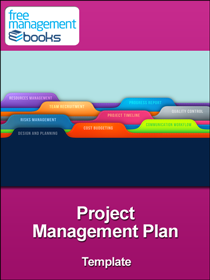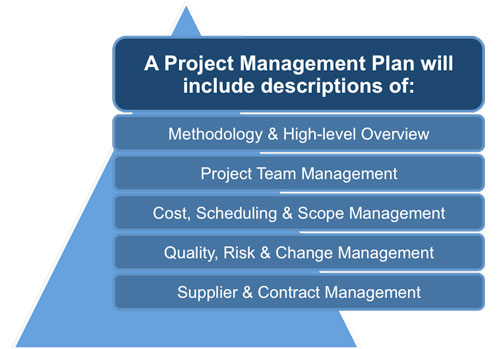
Project Management Plan Template
This project management plan template ensures that you have included every section necessary for the success of your project.
In the case of smaller projects, this plan can serve as a self-contained planning document. However, in larger projects it makes more sense to create a series of subordinate plans for each functional area (scope, budget, schedule, risk, quality, human resources, etc). Using the project plan as a parent plan that refers to these subordinate plans prevents it from becoming too lengthy and complex. The following outline provides a good foundation for a project management plan but you will need to use your own judgment about which sections to use and how much detail to go into.
Background
It is inevitable that updates from approved changes during the project may significantly impact parts of this document and will provide greater precision with respect to schedule costs and resource requirements. A working version will need to be released to the project team at some point so that they know what they are supposed to be doing at any point in time. To check whether your project management plan is complete there are several questions that require a ‘Yes’ answer to the following questions:
• Does it include all known major project tasks?
• Is it in sufficient detail to generate work packages?
• Are all activities in their chronological sequence?
• Are the task interdependencies clear?
• Is it easy to understand?
• Does it make clear to everyone involved what they are expected to do?
• Can everyone see what is being done in the next few weeks?
• Does it have broad acceptance amongst the stakeholders?
• Is it flexible and able to take account of changes?
• Are the milestones shown?
• Are the duration estimates achievable?
• Are urgent and high-priority tasks clearly highlighted?
• Can it be used to check day-to-day progress?
• Does it take account of the available resources?
When all your answers are yes you know that your project plan contains all the key information and plans that you require to manage, monitor and implement your project successfully.
This plan contains all the key information and plans that you require to manage, monitor and implement your project successfully.
Project Plan Components
- Project Management Approach – is similar to an executive summary in that it provides an overview of the management approach to the whole project. This is where you state who makes up the project team, along with their skills, role and level of authority. You also need to describe which departments, divisions and suppliers will provide the project’s required resources. This also needs to state at a high-level any constraints or limitations associated with these resources.
- Human Resources (HR) Management – defines the core people, plus their skills and expertise that is required for your project. These core individuals will be committed to the project for its entirety and details of other resources required throughout the project are described in this section. You will outline how you will acquire, develop and manage all your project resources.
- Communications Management – forms the foundation of how you as project manager will identify and manage the various working relationships needed for your project. An essential aspect is to identify your stakeholders and their level of interest in the project so that you can properly manage their expectations. You will also define how (email, memo, meetings etc.) and when you will communicate with them to ensure they are kept informed of progress.
- Scope Management – details exactly what your project is, whom you need to communicate with to gain approval and sign-off for your project to. The objective of this section is to ensure that everyone involved has been thoroughly communicated with and has a comprehensive understanding of what your project means to them and the organization.

Within this section you will document and collate the ‘end users’ requirements and gain agreement for what they expect as a final product. The project charter provides a broad overview to which you need to add a stakeholder register and once the scope is verified demonstrates their acceptance of the project deliverables.
- Schedule Management – provides the feasible delivery dates for each phase of your project and the final completion date. The milestones of your project are described in this section along with any known constraints. Controlling this area will be critical to the success of your project in a timely and cost effective manner.
- Cost Management – is the section where you provide detailed figures on all the estimated costs of your project. As project manager you will outline how you will manage, report and control the projects budget so that it achieves the promised return on the organization’s investment. A common technique used in this area is Earned Value Management (EVM) where your forecast of expenditure is compared to the projects actual costs.
- Quality Management – defines the quality standards the project must meet and how you will mange the compliance of deliverables. When a project fails to meet its quality requirements there are serious repercussions on the delivery and acceptance of the project, so it is a key area to define appropriately.
- Change Management – is a critical aspect of your project because this is where you define ‘who’ has the authority to approve change requests and how those change requests will be managed and approved. As more and more organizations become project based entities it is likely that you will need to liaise with a ‘Change Control Board’ or ‘CCB’ that manages, records and monitors this aspect of projects.
- Risk Management – within this section of your project management plan you describe how you will identify, assess and manage risks. For each risk you will assign a level of seriousness, probability and likely impact of each risk, which will be documented in your Risk Breakdown Structure (RBS). As your project progresses the risk register and planned responses will be updated, as risks are no longer relevant and new ones occur.
- Supplier and Contract Management – identifies the products, services and resources that need to be acquired or purchased from outside of the project team. It will include the timeframe for each resource and the quoting and management processes attached to this procurement.
